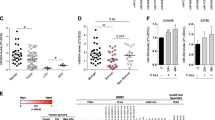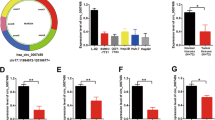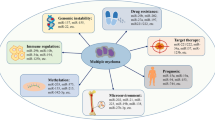Abstract
MicroRNAs (miRNAs) are a class of small non-coding regulatory RNAs, and changes in miRNAs are involved in tumor origin and progression. Studies have shown that miR-20a is overexpressed in human ovarian cancer tissues and that this miRNA enhances long-term cellular proliferation and invasion capabilities. In this study, a positive correlation between serum miR-20a expression and ovarian cancer stage was observed. We found that miR-20a binds directly to the 3′-untranslated region of MICA/B mRNA, resulting in its degradation and reducing its protein levels on the plasma membrane. Reduction of membrane-bound MICA/B proteins, which are ligands of the natural killer group 2 member D (NKG2D) receptor found on natural killer (NK) cells, γδ+ T cells and CD8+ T cells, allows tumor cells to evade immune-mediated killing. Notably, antagonizing miR-20a action enhanced the NKG2D-mediated killing of tumor cells in both in vitro and in vivo models of tumors. Taken together, our data indicate that increased levels of miR-20a in tumor cells may indirectly suppress NK cell cytotoxicity by downregulating MICA/B expression. These data provide a potential link between metastasis capability and immune escape of tumor cells from NK cells.
This is a preview of subscription content, access via your institution
Access options
Subscribe to this journal
Receive 12 digital issues and online access to articles
$119.00 per year
only $9.92 per issue
Buy this article
- Purchase on Springer Link
- Instant access to full article PDF
Prices may be subject to local taxes which are calculated during checkout





Similar content being viewed by others
References
Wu J, Groh V, Spies T . T cell antigen receptor engagement and specificity in the recognition of stress-inducible MHC class I-related chains by human epithelial gamma delta T cells. J Immunol 2002; 169: 1236–1240.
Oppenheim DE, Roberts SJ, Clarke SL, Filler R, Lewis JM, Tigelaar RE et al. Sustained localized expression of ligand for the activating NKG2D receptor impairs natural cytotoxicity in vivo and reduces tumor immunosurveillance. Nat Immunol 2005; 6: 928–937.
Eleme K, Taner SB, Onfelt B, Collinson LM, McCann FE, Chalupny NJ et al. Cell surface organization of stress-inducible proteins ULBP and MICA that stimulate human NK cells and T cells via NKG2D. J Exp Med 2004; 199: 1005–1010.
Andresen L, Hansen KA, Jensen H, Pedersen SF, Stougaard P, Hansen HR et al. Propionic acid secreted from propionibacteria induces NKG2D ligand expression on human-activated t lymphocytes and cancer cells. J Immunol 2009; 183: 897–906.
Li K, Mandai M, Hamanishi J, Matsumura N, Suzuki A, Yagi H et al. Clinical significance of the NKG2D ligands, MICA/B and ULBP2 in ovarian cancer: high expression of ULBP2 is an indicator of poor prognosis. Cancer Immunol Immunother 2009; 58: 641–652.
Zhao S, Wang H, Nie Y, Mi Q, Chen X, Hou Y . Midkine upregulates MICA/B expression in human gastric cancer cells and decreases natural killer cell cytotoxicity. Cancer Immunol Immunother 2012; 61: 1745–1753.
Hedlund M, Nagaeva O, Kargl D, Baranov V, Mincheva-Nilsson L . Thermal- and oxidative stress causes enhanced release of NKG2D ligand-bearing immunosuppressive exosomes in leukemia/lymphoma T and B cells. PLoS ONE 2011; 6: e16899.
Cheng M, Chen Y, Xiao W, Sun R, Tian Z . NK cell-based immunotherapy for malignant diseases. Cell Mol Immunol 2013; 10: 230–252.
Kaiser BK, Yim D, Chow IT, Gonzalez S, Dai Z, Mann HH et al. Disulphide-isomerase-enabled shedding of tumor-associated NKG2D ligands. Nature 2007; 447: 482–486.
Zhang C, Zhang J, Wei H, Tian Z . Imbalance of NKG2D and its inhibitory counterparts: how does tumor escape from innate immunity. Int Immunopharmacol 2005; 5: 1099–1111.
Perera L, Shao L, Patel A, Evans K, Meresse B, Blumberg R et al. Expression of nonclassical class I molecules by intestinal epithelial cells. Inflamm Bowel Dis 2007; 13: 298–307.
Champsaur M, Lanier LL . Effect of NKG2D ligand expression on host immune responses. Immunol Rev 2010; 235: 267–285.
Bartel DP . MicroRNAs: genomics, biogenesis, mechanism, and function. Cell 2004; 116: 281–297.
Lai EC . Micro RNAs are complementary to 3′UTR sequence motifs that mediate negative post-transcriptional regulation. Nat Genet 2002; 30: 363–364.
Nam EJ, Yoon H, Kim SW, Kim H, Kim YT, Kim JH et al. MicroRNA expression profiles in serous ovarian carcinoma. Clin Cancer Res 2008; 14: 2690–2695.
Wyman SK, Parkin RK, Mitchell PS, Fritz BR, O'Briant K, Godwin AK et al. Repertoire of microRNAs in epithelial ovarian cancer as determined by next generation sequencing of small RNA cDNA libraries. PLoS ONE 2009; 4: e5311.
Li C, Fang Z, Jiang T, Zhang Q, Liu C, Zhang C et al. Serum microRNAs profile from genome-wide serves as a fingerprint for diagnosis of acute myocardial infarction and angina pectoris. BMC Med Genomics 2013; 6: 16.
Zeng X, Xiang J, Wu M, Xiong W, Tang H, Deng M et al. Circulating miR-17, miR-20a, miR-29c, and miR-223 combined as non-invasive biomarkers in nasopharyngeal carcinoma. PLoS ONE 2012; 7: e46367.
Liao Y, Du X, Lönnerdal B . miR-214 regulates lactoferrin expression and pro-apoptotic function in mammary epithelial cells. J Nutr 2010; 140: 1552–1556.
Li J, Cui L, He W . Distinct pattern of human Vdelta1 gammadelta T cells recognizing MICA. Cell Mol Immunol 2005; 2: 253–258.
Tsukerman P, Stern-Ginossar N, Gur C, Glasner A, Nachmani D, Bauman Y et al. MiR-10b downregulates the stress-induced cell surface molecule MICB, a critical ligand for cancer cell recognition by natural killer cells. Cancer Res 2012; 72: 5463–5472.
Cox MB, Cairns MJ, Gandhi KS, Carroll AP, Moscovis S, Stewart GJ et al. MicroRNAs miR-17 and miR-20a inhibit T cell activation genes and are under-expressed in MS whole blood. PloS ONE 2010; 5: e12132.
Lewis BP, Burge CB, Bartel DP . Conserved seed pairing, often flanked by adenosines, indicates that thousands of human genes are microRNA targets. Cell 2005; 120: 15–20.
Schreiber RD, Old LJ, Smyth MJ . Cancer immunoediting: integrating immunity's roles in cancer suppression and promotion. Science 2011; 331: 1565–1570.
Matejuk A, Collet G, Nadim M, Grillon C, Kieda C . MicroRNAs and tumor vasculature normalization: impact on anti-tumor immune response. Arch Immunol Ther Exp 2013; 61: 285–299.
Li X, Zhang Z, Yu M, Li L, Du G, Xiao W et al. Involvement of miR-20a in promoting gastric cancer progression by targeting early growth response 2 (EGR2). Int J Mol Sci 2013; 14: 16226–16239.
Wu Q, Yang Z, Wang F, Hu S, Yang L, Shi Y et al. MiR-19b/20a/92a regulates the self-renewal and proliferation of gastric cancer stem cells. J Cell Sci 2013; 126: 4220–4229.
Fan X, Liu Y, Jiang J, Ma Z, Wu H, Liu T et al. miR-20a promotes proliferation and invasion by targeting APP in human ovarian cancer cells. Acta Biochim Biophys Sin 2010; 42: 318–324.
Wang K, Zhang S, Weber J, Baxter D, Galas DJ . Export of microRNAs and microRNA-protective protein by mammalian cells. Nucl Acids Res 2010; 38: 7248–7259.
Mitchell PS, Parkin RK, Kroh EM, Fritz BR, Wyman SK, Pogosova-Agadjanyan EL et al. Circulating microRNAs as stable blood based markers for cancer detection. Proc Natl Acad Sci USA 2008; 105: 10513–10518.
Chen X, Ba Y, Ma L, Cai X, Yin Y, Wang K et al. Characterization of microRNAs in serum: a novel class of biomarkers for diagnosis of cancer and other diseases. Cell Res 2008; 18: 997–1006.
Acknowledgements
This work was supported by the Medical Science and Technology Development Foundation of Nanjing (Department of Health, grant numbers YKK12076 and QRX11243) and the National Natural Science Foundation of China (grant number 81201598). We thank Dr Hui Wang and Professor Yayi Hou for their helpful comments on the manuscript.
Author information
Authors and Affiliations
Corresponding author
Ethics declarations
Competing interests
The authors do not report any conflict of interest regarding this work.
Rights and permissions
About this article
Cite this article
Xie, J., Liu, M., Li, Y. et al. Ovarian tumor-associated microRNA-20a decreases natural killer cell cytotoxicity by downregulating MICA/B expression. Cell Mol Immunol 11, 495–502 (2014). https://doi.org/10.1038/cmi.2014.30
Received:
Revised:
Accepted:
Published:
Issue Date:
DOI: https://doi.org/10.1038/cmi.2014.30
Keywords
This article is cited by
-
Unraveling the microRNAs, key players in folliculogenesis and ovarian diseases
Middle East Fertility Society Journal (2024)
-
Disable 2, A Versatile Tissue Matrix Multifunctional Scaffold Protein with Multifaceted Signaling: Unveiling Role in Breast Cancer for Therapeutic Revolution
Cell Biochemistry and Biophysics (2024)
-
Disabled-2, a versatile tissue matrix multifunctional scaffold protein with multifaceted signaling: Unveiling its potential in the cancer battle
Naunyn-Schmiedeberg's Archives of Pharmacology (2024)
-
Novel role of immune-related non-coding RNAs as potential biomarkers regulating tumour immunoresponse via MICA/NKG2D pathway
Biomarker Research (2023)
-
Stem cell-assisted enzyme/prodrug therapy makes drug-resistant ovarian cancer cells vulnerable to natural killer cells through upregulation of NKG2D ligands
Medical Oncology (2023)



